Is excess noise hurting productivity and focus in your office?
Implementing proper soundproofing enhances work quality by reducing disruptive noise.
Let’s dive into a complete step-by-step guide on how to soundproof your office for optimal working conditions.
Why Soundproof Your Office?
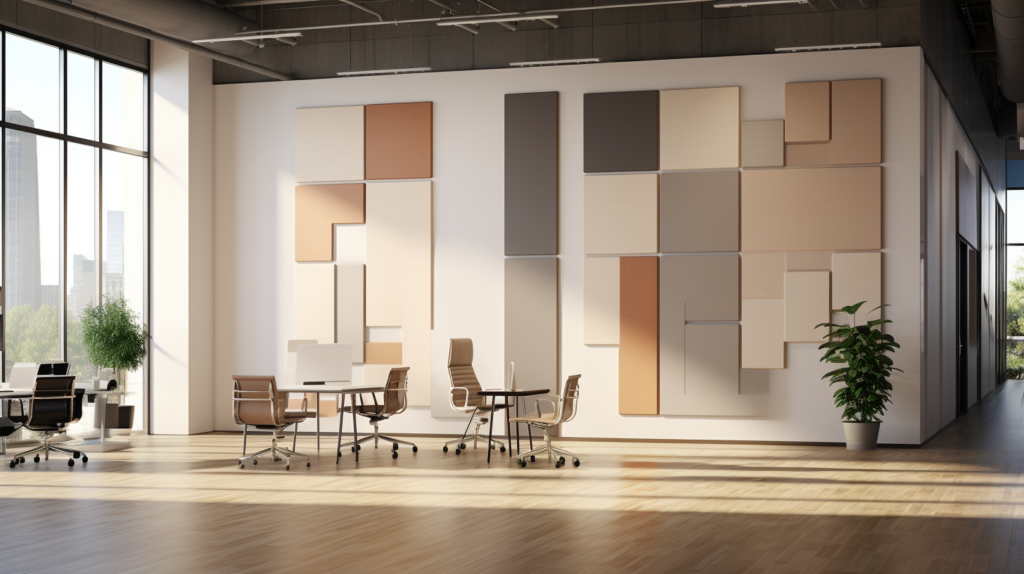
Improving office acoustics provides numerous benefits for your business. Excessive noise levels can negatively impact workers in a variety of ways.
Soundproofing helps create a comfortable work environment that enhances productivity and focus. There are several valid reasons to invest in properly soundproofing your office space.
Reducing distracting noises allows employees to concentrate better on their tasks. Ambient noise from conversations, office machinery or outside traffic can be very disruptive.
This makes it difficult to maintain attention and decreases efficiency. When soundproofing measures are implemented, the amount of noise distractions goes down.
Workers can stay fully engaged in their work without constant auditory disturbances. Their overall productivity and job satisfaction improves as a result.
Proper office soundproofing also ensures confidentiality for sensitive discussions. Phone calls or meetings about private company information can easily be overheard in a typical open plan office.
The lack of acoustic separation means noises transmit freely across the entire space. Installing acoustic partitions and soundproof rooms contained private conversations.
Noises are not able to pass between spaces or leak out. This allows for discreet communication without concern over who might be listening.
It provides privacy when handling financials, legal matters, personnel issues or client information.
Adequate sound insulation helps prevent noise fatigue among employees. Constant exposure to office chatter, equipment hums and phones ringing can be mentally draining.
This causes greater irritation, stress and headaches over the course of a workday. By absorbing excessive sounds through foam panels, carpeting and other materials, the office is kept at a lower, more comfortable volume.
Workers do not get worn out as quickly from high noise levels. Their overall health and wellbeing is improved with better acoustics.
Presenting a professional image is also a motivation behind soundproofing. For client meetings held at the office, you want to project competence and quality.
Noise bleeding through walls or a loud, chaotic environment undermines that goal. But well-soundproofed rooms with clean, peaceful acoustics convey operational excellence.
Clients are impressed by an office designed to enable confidential discussions and minimize distractions during important consultations.
Lastly, in many locations there are occupational safety regulations regarding office noise. OSHA sets legal limits on noise exposure to protect worker hearing health.
Sound levels consistently above 85 decibels over an 8 hour period can damage hearing over time. Excessive ambient noise could mean your office is out of compliance.
Proper soundproofing helps control volume to safer maximums. This avoids regulatory fines while also demonstrating you value employees’ long-term wellbeing.
Step by Step On How To Soundproof Your Office
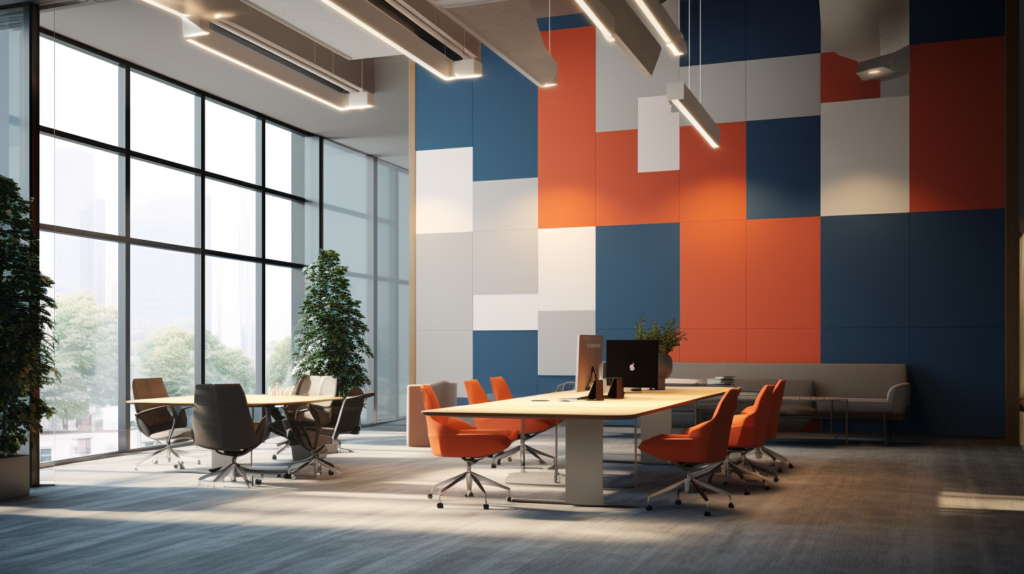
Soundproofing an office requires a multi-pronged approach to effectively control noise. There are many potential sources of disruptive sound, from loud machinery to chatter to outside traffic.
Luckily, with deliberate acoustic planning and treatments, these noises can be minimized.
Implementing the following comprehensive steps will transform your office into a peaceful, productivity-enhancing environment.
Careful attention to partitions, sound-absorbing materials, and layout considerations can make a significant impact on ambient noise reduction.
1. Use Acoustic Partitions to Divide Space

Installing partitions is one of the most effective ways to manage noise transmission in an open office format. Acoustic partitions are tall divider panels designed to absorb sound rather than reflect it.
They can be positioned to separate loud areas like conference rooms or call centers from quiet zones for focused work.
The absorptive materials in acoustic partition panels prevent noises on one side from disturbing people on the other side.
This allows completely different types of work activities to be conducted in close proximity without interfering with each other.
When selecting acoustic partitions, look for products with high noise reduction ratings. Panels constructed using sound-absorbing insulation or foam work best.
The dividers should also extend close to ceiling level in order to effectively contain noise.
Floor-to-ceiling is ideal if permitted by office height and fire code. Brands such as Kvadrat Soft Cells and Abstracta are known for high-performance office partitions that excel at reducing noise transfer.
Installing these thoughtfully around the office creates quieter separated spaces conducive to productivity and confidentiality.
To maximize noise isolation, make sure partitions make full contact with the floor, walls and ceiling with sealed edges.
Any air gaps around partitions can compromise acoustics and allow sound leakage. If partitions do not reach the ceiling, adding material across the top closes the gap.
Proper installation is key to prevent noise flanking. Also consider sliding partitions on ceiling tracks to permit flexible space division as needed.
Invest strategically in quality partitions suited for your office layout and they will pay dividends in noise reduction.
2. Create Soundproof Booths
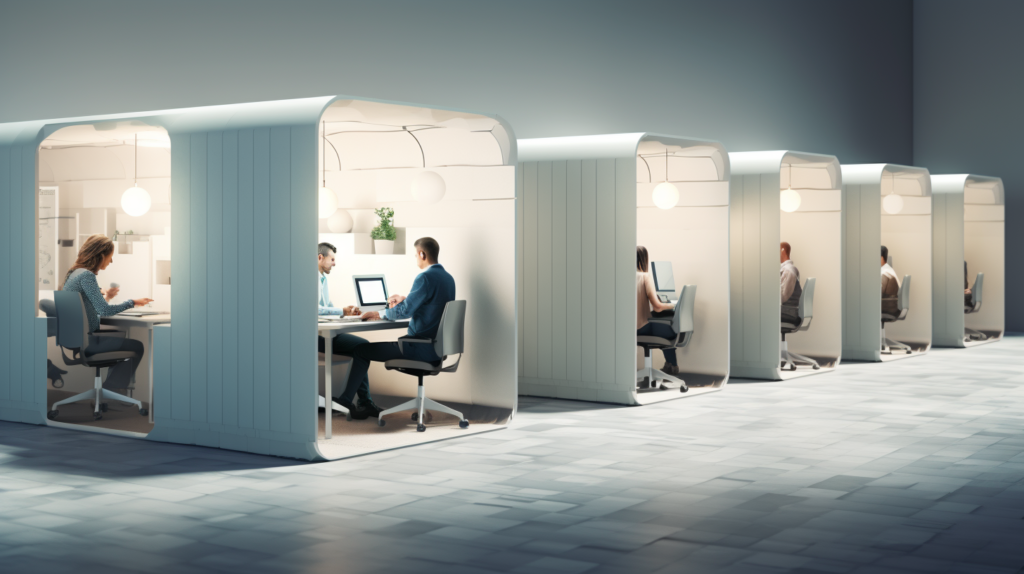
Another useful soundproofing tactic is setting up small individual booths for private calls or focused work.
These enclosed pods block outside noise and contain any noise generated inside. Acoustic foam padding on the walls minimizes sound reverberations within the booth.
Some premium designs even have active noise cancellation technology for maximum quietness.
Booths give employees a silent sanctuary they can retreat to for intense concentration work.
Sales staff can use booths to take client calls without distracting coworkers. Engineers can isolate themselves in a booth for complex design work requiring unbroken focus.
The isolation promotes better work quality while demonstrating respect for colleagues. Having multiple booths situated around the office provides flexibility for people to optionally avoid noise as needed.
Look for plug-and-play booth solutions that allow easy setup and relocation as office needs evolve. Many quality options assemble in minutes without tools for installation.
Brands such as Zenbooth and TalkBox offer high-end soundproof booth solutions suitable for professional offices.
Investing in a few booths creates occupational choice for employees in how they manage their sound environment. For big open offices, they are an excellent supplemental noise solution.
3. Strategic Space Planning
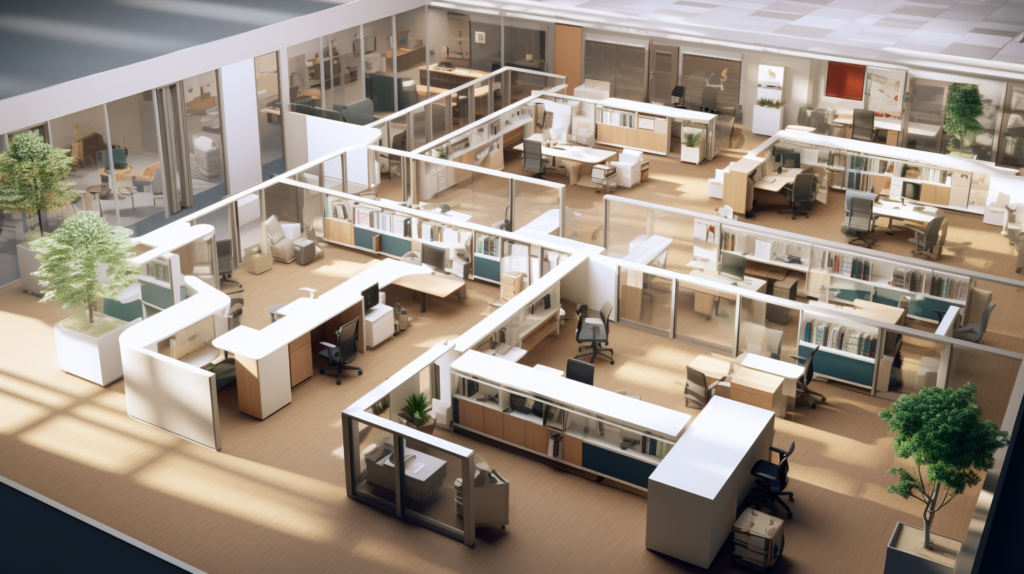
How you arrange your office layout and position employees plays a big role in noise control. Strategically clustering similar work zones together helps contain noise to appropriate areas.
More collaborative spaces where frequent discussions and meetings occur should be grouped together.
Intense focus workstations for tasks like programming or data analysis should be separated into their own quiet zones.
Large open workspaces can be segmented using floor-to-ceiling partitions as discussed above. However, also consider taking advantage of existing architectural elements.
Enclosed rooms with doors naturally limit sound travel. Locate loud departments next to hallway buffers instead of directly against quieter teams.
Every office layout will be unique, but always be intentional about keeping noisy areas insulated from those needing unbroken concentration.
In addition to physical distancing, also consider scheduling adjustments to coordinate high-collaboration activities during certain hours of the day.
Noise-sensitive work could be planned for early morning and late afternoon periods. More disruptive interactive tasks can take place mid-day when separation is harder.
The goal is to create as much acoustic isolation between contrasting work modes as possible through space planning.
High wall partition systems are ideal for dividing large workspaces. Unlike cubicles, full height partitions nearly reach the ceiling which prevents noise drifting over the top.
They create defined personal spaces while their sound-absorbing materials minimize noise transfer laterally between workstations.
Brands such as he Storage Wall provide customizable floor-to-ceiling partition solutions to effectively divide open offices.
4. Incorporate Large Plants

Incorporating large potted plants into an office’s decor serves an acoustic purpose alongside their aesthetic appeal.
Plants naturally help absorb and diffuse noise within indoor spaces. The leaves and soil provide sound-dampening similar to acoustic foam or insulation.
Greenery also breaks up sightlines which psychologically provides a sense of sonic privacy.
Strategically place plants in spots where excess noise is problematic around the office. This includes areas near noisy equipment such as printers or air handling systems.
Plants can also help border divisions between workspaces to further bolster the partitions. Choose larger, leafy varieties for maximum sound absorption capabilities.
Snake plants, palms, ferns and philodendrons are good options. Place them in decorative planters to contribute to the office ambiance.
Remember to include a watering and sunlight plan when bringing in office plants for noise control. Appoint someone to properly care for them so they remain healthy and thriving.
The addition of office plants as a supplementary sound dampener is an easy way to incrementally improve overall acoustics. Just be sure to maintain them so they continue serving their acoustic purpose.
5. Install Soundproof Meeting Rooms
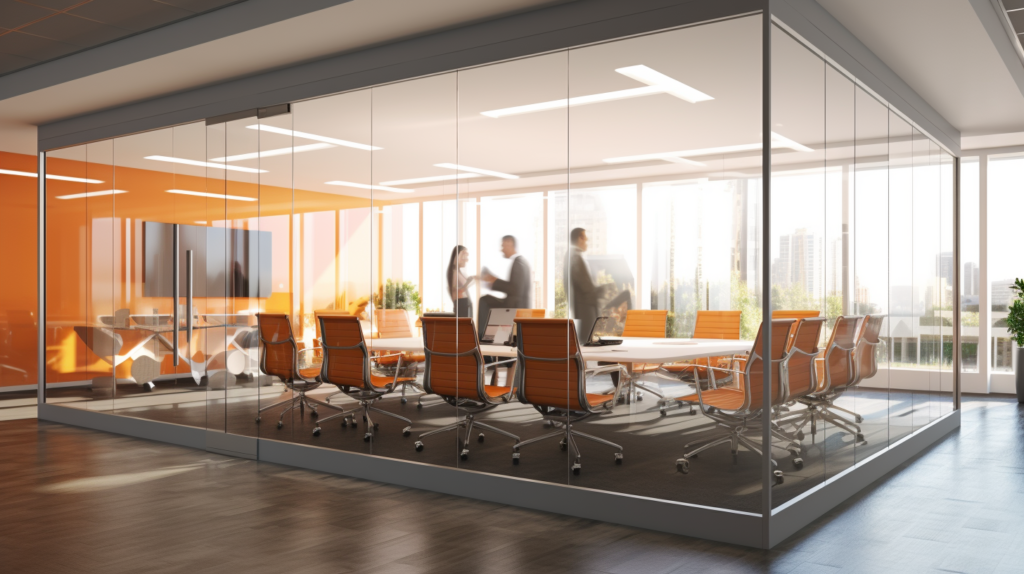
Closed meeting rooms already provide noise isolation by virtue of their enclosed structure.
However, standard drywall construction alone is not enough to contain loud voices, presentation sounds or long conference calls.
Upgrading meeting room walls to proper soundproofing standards is recommended to prevent noise disturbances.
An effective method is using soundproof glass partitions or windows when constructing meeting room walls.
Brands such as Tru-Quiet Windows offer specialty glass layered with noise damping compounds. This allows natural light transmission while reducing audio transmission.
The inclusion of noise reducing acoustic foam panels on surrounding perpendicular walls adds further sound absorption.
For increased privacy, electronic white noise generators can provide ambient background sound to mask voices.
The white noise makes it very difficult for occupants’ conversations to be intelligible to those outside the room.
When external noise sources are a factor, adequate soundproofing allows for productive long meetings without interruption.
Look for meeting rooms offerings advanced features such as noise-cancelling technology and automated acoustic tuning.
Hardware capabilities that optimize room acoustics for the number of occupants and use case are emerging.
Touchscreen controls allow rooms to be tuned for presentations, video conferencing or relaxed discussion seamlessly. Intelligent acoustic design ensures meeting productivity.
6. Add Desk Dividers
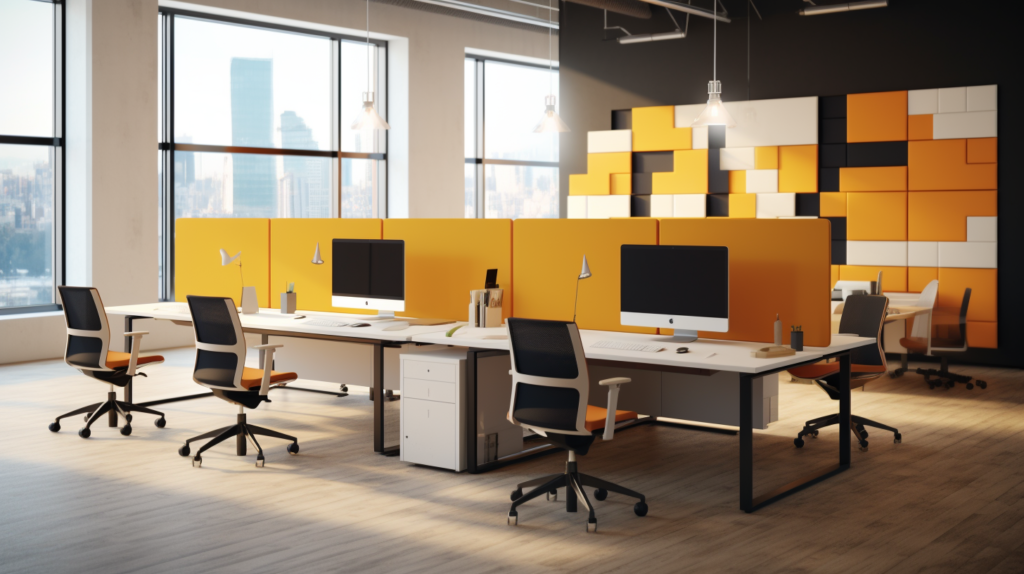
In open plan offices, desk dividers are a simple solution to absorb noise between closely spaced workstations.
The soft, sound-dampening material of desk divider panels prevents voices and other ambient sounds from carrying between desks.
This allows for some speech privacy and reduced distraction.
Look for desk dividers constructed from acoustic materials like fabric, polyester fiber or felt. Models with internal sound-absorbing properties work better than basic hard-surface dividers.
Brands such as Desk Dividers Direct offer attractive options made specifically to improve acoustic isolation as well as visual privacy.
Position the panels to obstruct noise pathways between desks or work areas. Dividers that extend above seated head height provide better absorption for standing noises.
Outdoor business events may benefit from freestanding acrylic dividers to separate booths and demonstrations.
While not a complete soundproofing fix, the addition of desk dividers does make a notable improvement in open office acoustics at an affordable cost.
7. Use Sound-Absorbing Materials
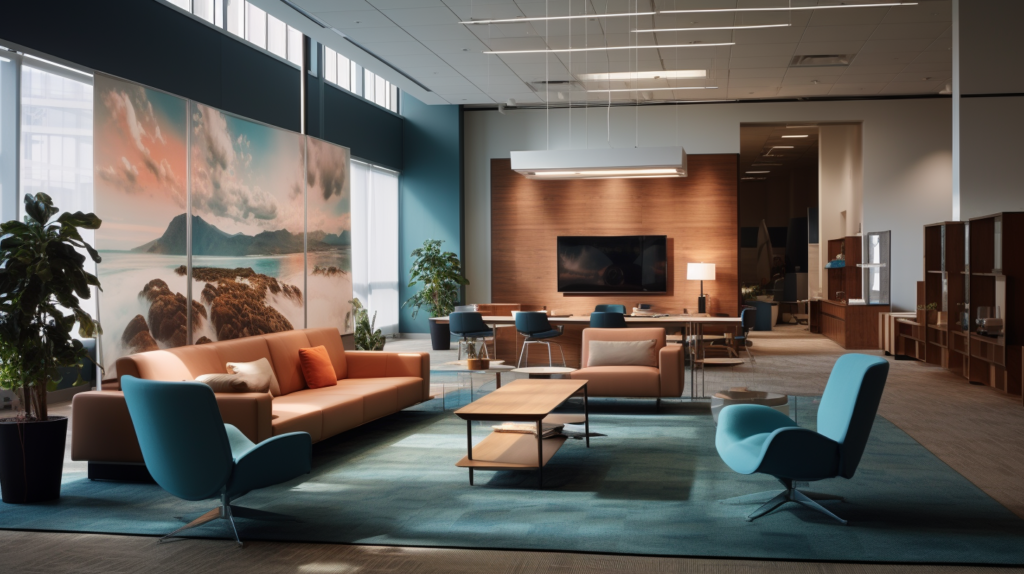
Supplementing office furnishings and surfaces with sound-absorbing materials is an important step. Hard, reflective surfaces like concrete, tile or glass can cause excessive noise reverberation indoors.
The echo effect creates loud, unpleasant working conditions and hampers speech intelligibility. Acoustic materials introduce softness to absorb office noise and reduce amplification.
Carpeting flooring rather than bare floors makes a big difference in limiting sound propagation. The fibers and cushioning pad absorb footfall noise and prevent reverberation.
Workstations can be further buffered with the addition of area rugs. Fabric-upholstered furniture also dampens noise compared to leather or mesh chairs and sofas.
Individual fabric wall hangings provide artistic accents while serving as another acoustic buffer.
Wall installation of acoustic foam panels or insulation batting reduces echoes and ambient noise within the office.
These can be tastefully incorporated into booths, meeting rooms and open areas requiring sound absorption.
Where office architecture allows, hanging baffles from ceilings is also an effective acoustic treatment. Baffles strategically absorb overhead noise for occupants below.
Other Tips

Here are some additional best practices for maintaining a quiet professional office environment:
- Encourage employees to use headsets for phone calls rather than relying on speakerphone. Headsets localize noise disturbance instead of filling the ambient space. Provide quality headsets if they are not already supplied.
- Provide white noise or environmental sound machines for areas needing acoustic masking. These devices wash out intrusive background sounds with constant, unobtrusive white noise. Masking creates a more uniform background audio environment.
- Have a culture that respects noise etiquette – silence phones in meetings, go to lounges for extended conversations, close doors when possible. Signage can politely reinforce expectations about noise courtesy.
- Select office machinery and equipment such as printers, computers and servers for low noise operation. Place these devices away from focus work zones. Use noise-reducing enclosures as needed.
- Seal potential air leak points with acoustic caulk to prevent noise intrusion from outside. Weatherstrip doors and windows and seal outlets, pipes and other openings. Stopping airborne sound pathways is crucial.
Properly soundproofing an office space requires a holistic approach addressing all potential noise sources and paths.
But the investment into acoustic treatments pays dividends through healthier, happier and more productive employees.
Follow these steps to create a quieter office environment conducive to focus and collaboration.
Conclusion
Properly soundproofing your office requires attention to detail, but brings immense benefits for productivity and wellbeing.
By following the comprehensive steps outlined here, you can achieve a peaceful, professional acoustic environment.
Employees will be thankful for the reduced noise distractions and fatigue. Clients will take notice of your commitment to quality and confidentiality.
Prioritize office acoustics and you will reap rewards for your business’ success.
